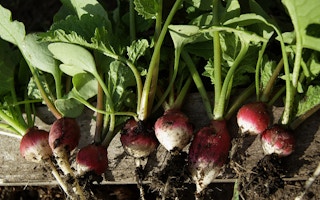A novel way to reduce the UK’s emissions of greenhouse gases has been proposed by researchers: simply raise the water table in agricultural peatland.
A third of greenhouse gases (GHGs) released by humans come from agriculture, and at the same time the UK’s remaining peatland is being lost rapidly. This new approach promises to tackle both problems.
Research led by scientists from the University of Sheffield found that increasing by 20 centimetres the level below which the ground is saturated with water – the water table – in radish fields yields several benefits.
Not only does it cut soil CO2 emissions, it also improves crop growth, and helps to reduce the rate of loss of peat soils converted into agricultural fields.
Although cutting the GHG contribution from agriculture is essential to slow climate change, the world’s growing population needs more food − and the farmland to grow it.
“
Flooding peatland would be too extreme and damage crops, but increasing the water level by just 20cms maintains current food production.
Donatella Zona, research fellow and lecturer in the University of Sheffield’s Department of Animal and Plant Sciences
Drained peatland
A significant amount of UK farming is on drained peatland, which has some of the most productive soils for commercial agriculture. But draining naturally-flooded peatland, which is organically rich, prompts the carbon to oxidise and release CO2 into the atmosphere.
The senior author of the study, Dr Donatella Zona, research fellow and lecturer in the University of Sheffield’s Department of Animal and Plant Sciences, says: “It is estimated that in 30 years’ time the world’s population will reach 10 billion, so it is vital that any means of reducing greenhouse gas emissions does not impact negatively on global food security.
“We are losing our peat soils in the UK at a fast rate, and we need to find solutions to decrease this loss if we want to preserve our food security.
“In this study, we investigated the effects of water table levels, elevated CO2 and agricultural production on greenhouse gas fluctuations and the crop productivity of radishes, which are one of the most economically important fenland crops.”
The Fens are an area of low-lying fertile farmland in eastern England.
Dr Zona stressed the research’s preliminary nature: “This is a first laboratory experiment, which oversimplifies the ‘real world’ conditions experienced by farmers. And we tested what happens with only one crop. We have no information about other crops yet, and we should perform this same test both in the lab and in the field.”
The international team of researchers from three UK universities – Sheffield, Exeter and Leicester – and one in the US, San Diego, raised the water table from 30cm to 50cm in agricultural peat soil collected from the Norfolk Fens – one of the UK’s largest lowland areas of peatland under intensive cultivation.
Food production
Dr Zona says: “Flooding peatland would be too extreme and damage crops, but increasing the water level by just 20cms maintains current food production – or, as shown in our study, even increases it – while at the same time reducing carbon oxidation and emissions.”
The findings, published in Science of the Total Environment journal, showed that raising the water table increased the average uptake of CO2.
Professor Walter Oechel, of the University of Exeter, says: “Reducing CO2 emissions from peatland soils will not only help the UK to reach the targets set for the Paris climate agreement, but will also help protect and extend the life of the UK’s agricultural peatland soils.
“Without careful management, agricultural peatland soils can be ‘mined’ or consumed in the production of agricultural crops, leaving the UK with less productive lands in their place.”
The study, led by University of Sheffield students Charlotte Atherton and Samuel Musarika, will now analyse other crops, including celery, and will look into the impact of fertiliser use on greenhouse gas emissions and productivity.
This story was published with permission from Climate News Network.










